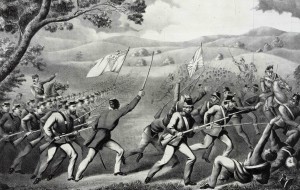The Fenian Invasion Of Canada, 1866
 Ian Kenneally the author of From The Earth, A Cry: the story of John Boyle O’Reilly published by The Collins Press writes about the Fenian invasion of Canada in 1866.
Ian Kenneally the author of From The Earth, A Cry: the story of John Boyle O’Reilly published by The Collins Press writes about the Fenian invasion of Canada in 1866.
In June 1866 a group of Fenian soldiers crossed the border from the United States into Canadian territory. The events of the so-called Fenian invasion of Canada would leave the organisation utterly discredited and cause much dismay among Irish-American communities. This article examines why the Fenian Brotherhood undertook such a seemingly hopeless expedition.
The Plan
The roots of the invasion went back to 1865 when the Fenians in the United States had broken into two factions, one headed by William Roberts and the other led by John O’Mahony, a founding member of the Brotherhood. It was the Roberts Wing which proposed a Fenian invasion of Canada. A number of facts were put forward by Roberts and others in support of this plan. In 1865 there were tens of thousands of battle-hardened Irish veterans of the Civil War, as well as many officers from both the Union and Confederate armies. It was initially proposed to utilise these soldiers for an incursion into Canada that would be timed to coincide with a revolution in Ireland. Thus the British would be engaged in two widely separated theatres of war.
At the time the US Government had a fractious relationship with their British counterparts; a remnant of the British Empire’s partiality towards the Confederacy during the Civil War.
When it became apparent that the hoped-for rising in Ireland was not to take place (a small-scale Irish rising would eventually take place in 1867 but was defeated) the goal of the invasion was changed. The Fenians now hoped that they could engineer a border incident that would entangle British forces in a war with the United States.
At the time the US Government had a fractious relationship with their British counterparts; a remnant of the British Empire’s partiality towards the Confederacy during the Civil War. During that war the British Government had come close to granting diplomatic recognition to the Confederacy and British shipyards had provided raiding vessels such as the notorious Alabama to the South. While this ill-feeling was unlikely to lead to full-scale conflict the US Government was in no mood to provide any aid to the British in Canada. President Andrew Johnson was aware of the Fenian’s plans but did little to hinder them.
The Invasion
The two competing Fenian factions launched separate operations. In April 1866, the O’Mahony Wing attempted to seize Campobello Island near New Brunswick but the Fenian attackers were easily dispersed by US naval forces. The Roberts Wing launched its attack on Canada under the command of a civil war veteran, , on 1 June 1866.
General O’Neill led a force of over one thousand men into Canadian territory near Fort Erie in Ontario. His invading army had some initial success, winning two engagements including the so-called Battle of Ridgeway with the loss of around ten fatalities (with a similar number on the Canadian side). O’Neill’s troops kept their discipline and local civilians were respected, as were Canadian prisoners of war. One soldier, Lance Corporal William Ellis, later wrote that: ‘the Fenians treatment of myself and the other prisoners was kind and considerate in the extreme’.
Once back across the border, O’Neill’s army was met by American troops who intervened to prevent the Fenians from making any further attacks. Over the following days the Fenian army was broken up by American forces.
Yet, O’Neill was aware that far larger Canadian forces were approaching and on 3 June felt it prudent to take his army back to American territory, where they would await reinforcements. However, the US government was now fearful that events were spiralling out of control. Once back across the border, O’Neill’s army was met by American troops who intervened to prevent the Fenians from making any further attacks. Over the following days the Fenian army was broken up by American forces. O’Neill was arrested by US Marshalls and temporarily incarcerated. A second, smaller, incursion into Canada followed on 6 June but this, too, made little headway. This second Fenian army was also broken up by US forces when back on American soil. By 8 June the Fenian invasion of Canada was over.
The Aftermath
The whole invasion demonstrated the futility of the Fenian strategy. It proved that the Canadians would fight to preserve their territory and that they could mobilise thousands of their population to do so. There was little hope that the Fenians could muster the required number of troops necessary to seize and then to hold Canadian territory. Most importantly, there could be no doubt now that the US Government would not, despite its tempestuous relationship with the British Empire, offer any support to a Fenian invasion. Nor would the US Government allow itself to be embroiled in a border war with British or Canadian forces. Nevertheless, these lessons were ignored by some Fenians for whom the idea of attacking Canada remained a worthwhile objective over the next few years.
In 1870 another convention took place amid more internal wrangling within the Brotherhood. There, a decision was made to launch a new attack on Canada. Once again John O’Neill would command the Fenians, among whose army was John Boyle O’Reilly, a young journalist. O’Reilly would make detailed reports on the invasion: an event that would prove disastrous for Fenianism in the United States.